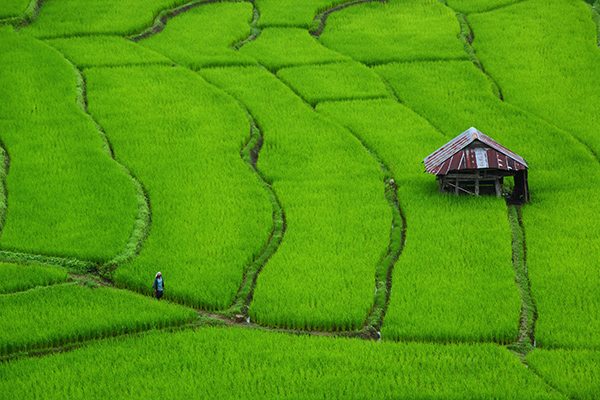In what is regarded as one of the first and certainly most important inscriptions in the Thai language, found carved on an ancient stele, there’s a bucolic description of the ancient kingdom of Sukhothai, part of which reads:
“In the time of King Ramkhamhaeng the Great, this land of Sukhothai is thriving. There is fish in the water and rice in the fields.”
[su_carousel source=”media: 51620,51621,51622,51619,51618″ link=”image” target=”blank” width=”660″ height=”440″ items=”1″ title=”no”]Thai historians claim these are the words of King Ramkhamhaeng the Great, ruler of the Sukhothai Kingdom from 1279–1298 and creator of the Thai alphabet, describing his lands during his reign. The mention of plentiful fish, as a way of portraying a nation that is at peace and thriving, shows how important fish have always been to the Thais as a source of food and a symbol of a settled civilisation. People, who live in a land where both fish and rice are abundant, will never go hungry.
Of course, fish have long been a source of protein in Southeast Asia. After all, this is a lush region fed by great rivers that wind their way across fertile plains, so fish have always been plentiful. Freshwater fish of many different species are easily caught in the streams and canals. During the wet season, when fish spawn and when waters are high, they can even be found swimming in flooded fields along with other nutritious treats; such as, crabs and molluscs.
To make the most of this bounty, Thai people used to dig ponds to trap and raise fish that were washed in by the floods. This is the source of the Thai proverb, Khut Bo Lo Pla or “Dig a Pond and Lure Fish”, that now describes someone who is benefitting by deception.
Breeding in the floodwaters and easily caught, these fish are regarded as having been given freely by nature spirits to nurture the people. This means that killing them for food isn’t seen as taking a life in the same way as eating other animals would be – an important distinction in a Buddhist country like Thailand.
Sometimes fish stranded by the floodwaters were released back into the rivers and streams as a way of making merit. This tradition survives, but these days many urban Thais who don’t work the fields will buy fish at the temple to release – this gives them a connection with their rural roots.
Over the cooler months of December, January and February which follow the rainy season, the fish are at their best after months of feeding in the nutrient-rich waters. This is the time of year when farmers are harvesting the new rice crop, so food is more abundant than ever – hence the Thai saying, Khao Mai Pla Man or “New Rice Fat Fish” to mean that everything is just perfect. This is that in past times, people were happier when food was most available. These days the phrase is used to describe newlyweds in those perfect early months of marriage.
Any remaining fish from the rainy season was dried or salted so that there was ample food for the rest of the year. These techniques of preserving fish have contributed to the unique flavours and textures that make up many popular Thai dishes and snacks – think, for example, of shrimp paste, and dried squid, the tiny dried prawns that go into Phat Thai or dishes; such as, Pla Wan, or the sun-dried-fish Pla Daet Dieo.
The fruits of the sea
Of course, as Thailand is a country with over 3,000 kilometres of coastline, hundreds of islands, mangroves, coral reefs and relatively tranquil seas, the kingdom’s fishing industry has long been important, not just for feeding the nation but also economically.
Thailand is the world’s third-largest supplier of seafood, and the industry is worth more than 200 billion Baht a year. So, if you’ve not experienced either Thailand’s amazing seafood, or visited some of the many charming fishing ports and villages around the country, you are missing out on an essential element of Thainess.
The Thai Gulf and Andaman Sea are rich with fish, squid, shrimp, lobster and scallops. But perhaps the most ubiquitous of fish is the small but tasty Pla Tu, a small mackerel which is salted and can be bought in nearly every town and village in Thailand, however far from the sea they might be.
Some of Thailand’s best known and most popular dishes are fish, or at least seafood, based. What would a Tom Yam soup be without juicy shrimps? How could a Thai feast be complete without fish cakes or crab fried rice? So important is fish to the Thai diet that, in times past, when people were too poor to afford fish to eat with their rice, they’d hang a small model cut-out of a fish in their home while eating their little bowls of rice.
Of course these days, Thais enjoy food from all over the world, and chicken and pork dishes are on every menu. But there’s still a special place in the heart of Thai people for fish. At a restaurant, most dishes are brought to the table when ready, and rarely attract comment from the diners, who just tuck in. But the fish dish, be it steamed in lemon or fried with garlic, is always given special treatment. It is presented by serving staff with a flourish, and is met with appreciative exclamations from the diners. When it comes to Thai cuisine, fish remains the centrepiece of the feast.
Fish sauce, an ever-present treat
Of course, if we’re looking at the importance of fish in Thailand, we can’t forget that most pungently pleasurable of ingredients, Nam Pla. This distinctively smelly and ever-so-salty fish sauce is as common on Thai tables as salt and pepper is in the West, and it serves much the same purpose – to impart flavour and enhance the taste of dishes.
There are many types of fish sauce found across Southeast Asia. Most are made with small fish; such as; anchovies which, after being caught, are cleaned and mixed with salt in large jars. These jars are left in the sunshine for the fish to ferment. After a few months, the fish liquefies and the result is that tasty sauce which Thai foodies love so much. There are many grades of fish sauce, but like olive oil, it’s the first batches to be siphoned from the jars that are considered to be of the highest quality.
Nam Pla is the most common ingredient used in Thai cooking and there are few dishes that don’t include it. As a table condiment, Nam Pla is mixed with chilies and a little lime juice to make the Prik Nam Pla – which is found in every roadside food stall or high-end restaurant. Some newcomers find Nam Pla’s rather distinctive aroma off-putting at first, but most of them soon become devotees, and even settle on their own favourite brand.
Gone fishing
If you’re visiting Thailand, you’re not restricted to enjoying the many fish dishes that Thai cuisine can boast. You may relish the challenge of catching some fish for yourself, on or off shore, or decide to spend a few hours simply messing around in a boat, it’s all easily arranged.
Big game fishing
Because of its associations with the writer Ernest Hemmingway, big game fishing is seen as rather a macho pursuit, a sort of bullfighting on boats. But it’s actually a popular hobby with men and women alike – though it can take no little strength to fight and reel in a large thrashing fish over several hours.
In Thailand, Phuket and the waters off Khao Lak are seen as the best place to catch the bigger fish and it is here that species; such as, Marlin, Sailfish, Barracuda, Spanish Mackerel and Tuna are to be found.
For the best big game fishing, you have to head further out to sea. This means that serious sports-fishing trips last a few days, so you live aboard the boat. Even if you don’t fancy picking up a rod and strapping yourself into the fighting chair, fishing trips give you a great chance to enjoy days at sea, and nights under the stars. There is a bonus to this as you’ll get to visit local islands and enjoy a close-up view of activities; such as, birds nest collecting.
Squid fishing
If you don’t think that big game fishing is for you, but you still want to enjoy a taste of the angler’s life, you may want to try a little evening squid fishing. As all Thai food lovers know, squid is big business in Thailand. Indeed, the lights from the vast fleets of squid fishing boats can actually be seen from the International Space Station.
You don’t need to be an expert angler to catch squid either. The lights, which are swung into position from the sides of the boat, do most of the work by luring the squid to the surface. All that remains for you to do is gently bob your rod up and down and hook any hapless creatures that come too close. Most people tend to catch at least one squid, and these are often prepared as instant sashimi to be enjoyed on the trip back to shore. Squid fishing can be arranged from nearly any of Thailand’s fishing ports including Pattaya, though the best months to go are between October and April.
Freshwater fishing
If you’re one of those unlucky souls who’s susceptible to seasickness, you’ll probably prefer to do your fishing on land. Luckily, Thailand has many freshwater lakes that have been stocked to attract sports fishermen.
In fact, Thailand can boast some of the world’s largest species of freshwater fish including Giant Catfish, Siamese Carp, Barramundi and the great predator, the Giant Snakehead. Records for big catches are regularly broken in the kingdom, with anglers reeling in some monster fish.
There are lakes up and down the country with some offering specialised fishing packages which include all tackle, lures, bait and transport. Some anglers may stay for several days, and rent floating bungalows, so that they are never far from the rod and reel action.
The growing popularity of freshwater fishing has led to a surge in aquaculture and fish farming, it is hoped that this will ensure the long-term survival of many threatened species.
Visit a fishing village
Even if you don’t want to catch your own lunch, it’s always fascinating to visit a fishing village and enjoy the comings and goings of the locals and look at the colourful boats. There are numerous charming villages up and down Thailand’s coastline, as well as on the islands.
Many of these now offer tours so you can head out in fishing vessels, see mussel and oyster farms and even watch the locals at work. This is a wonderful way of experiencing grassroots Thailand and of getting a unique perspective on the local wildlife. A visit to a fishing village usually means you get the chance to sample some of the freshest home-cooked sea food you’ll ever taste.
In summary, the importance of fish to Thai culture cannot be underestimated. For centuries, fish have not just been another ingredient but the main source of protein for the people. As a result, fish are as important to the kingdom’s cultural traditions, as they are to its culinary ones. So, next time you order a tasty fried Pla Kapong, sample a shrimp or simply flavour your food with a dash of Nam Pla, remember that you’re part of a life-sustaining Thai tradition that stretches back millennia.
Photo credits: all photos shown are some of the entries in the TAT Newsroom Contest 2014.






